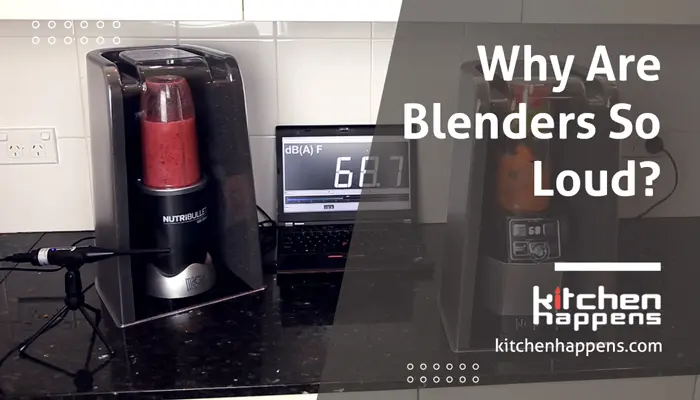No noise is good for the environment.
This is why a loud blender is also not acceptable either. A blender is a vital kitchen appliance that is almost always in use. But isn’t it unbearable if this blender makes a lot of noise and disturbs neighbors and family?
Of course, but have you ever thought about why are blenders so loud?
Indeed, your blender exceeds the level of extra noise, so now you wonder why! Don’t worry!! You come to the right place to fix your problem.
There are many reasons why a blender makes noise. Today I’m going to share the real reasons why your blender is making so much noise and finally get tricks to quiet your loud blender.
Therefore, first, let’s look at the science behind blender noises.
Why Are Blenders So Loud? Discover 12 Reasons:
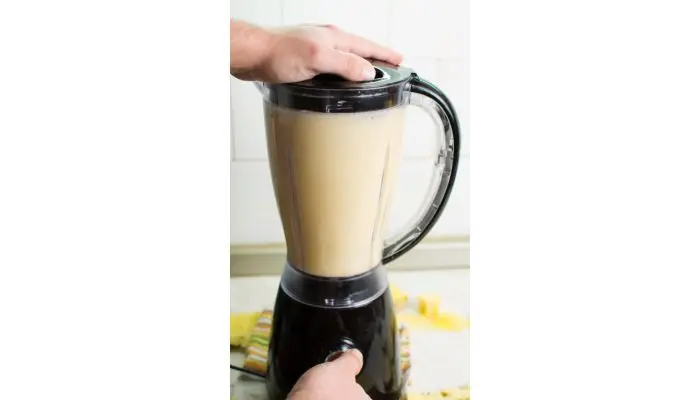
Blenders are complicated and require a high level of precision to operate. Unfortunately, most people do not realize that.
A blender contains an electric motor, bearings, gears, couplings, and fans. Your blender sets all of these parts in motion, the blades, and whatever is in your blender pitcher.
This creates a lot of vibration. Vibration leads to noise.
As blenders have many small parts moving at high speeds, they can be loud and noisy. Therefore, when blenders are used, they make noise due to this reason.
Below we show the individual factors that contribute to noise production. So take a deep dive into the below section.
1. Metal Blender Blades
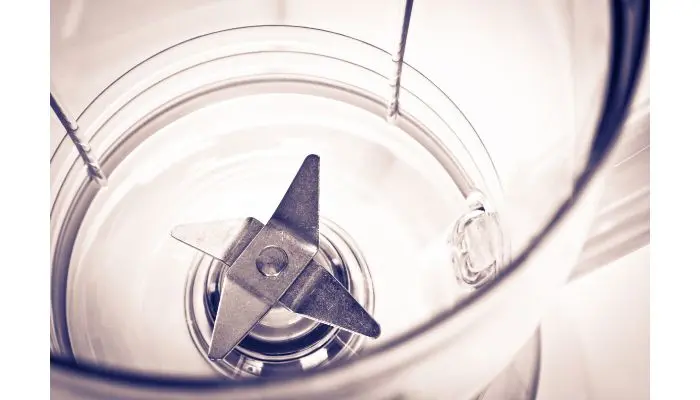
You will find that most blenders have metal blades.
Many blender makers use steel blades because steel blades can mix foods, even those that are hard or sticky. Whether it’s steel blades or any other metal, they tend to grind the motor.
As the metal blades rotate, they wear down components in the motor, causing loud noises and ultimately damaging the blender.
They wear down and get misshapen, which can cause significant problems.
A misshapen blade will rub against other parts of the blender or make more noise when blending certain foods.
2. High Speed
It’s very common that blenders sometimes need to run at high speeds to blend or mix up food.
Your blender needs to run longer and faster if you want it to blend or mix more subtly. As a result, your blender requires a lot of power to get the blades spinning at such a high speed.
Blenders become louder as its RPMs rise.
In addition, friction between the blender blades and the food can also cause noise.
When the blades connect with hard foods, such as ice, frozen fruits, or anything solid, they make a noise as they try to break it down or puree it.
More noise is generated when more foods are blended or when the food is harder or thicker.
3. Motor Problems
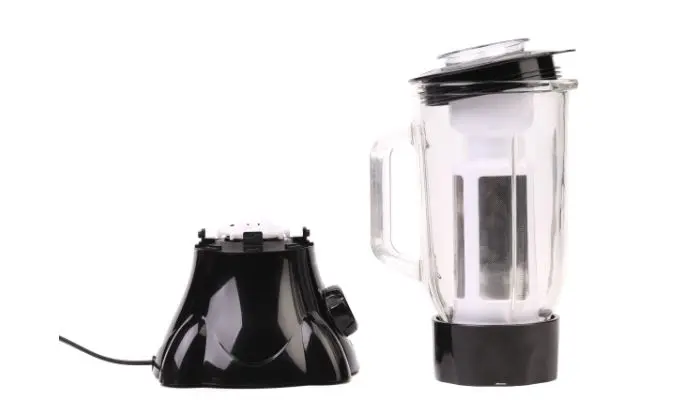
Older blenders have noisy motors, which make them difficult to use. It is sometimes possible for a blender to be loud due to a motor problem.
When the blender is a few years old, normal wear and tear may cause damage. Therefore, when blending at a faster or coarser speed, the blender must work harder, so the magnets need to be stronger.
As the parts move toward each other, stronger magnets, produce more noise.
Wear and tear on the engine may cause pieces to rub against each other, causing more friction, which makes it sound louder.
If you hear it, it can sound like dragging, metal falling upon metal, or even a rubbing sound.
4. Quality Of Blender
It is natural that a low-budget product will perform poorly.
People usually buy low-budget blenders. A low-quality blender usually comes with low-quality components, which can malfunction anytime.
When comparing a cheap blender with an expensive one, you’ll notice a significant difference in the sound produced. Generally, metal and plastic materials make your blender louder.
Expensive blenders are not only made up of premium quality products but are also equipped with noise-absorbing features.
5. High RPM
The most recent blenders come with a capacity of up to 2500 RPMs, which is higher than some of the previous models.
Basically, it can perform almost twice as fast as a standard blender could operate. Since it is spinning at such a high speed, it obviously requires more power. Therefore, the motor will start to get hot.
At times, this leads to serious damage. It is also important to note that the motor has to endure excessive pressure, making it sound so loud sometimes.
6. Cleaning Issues
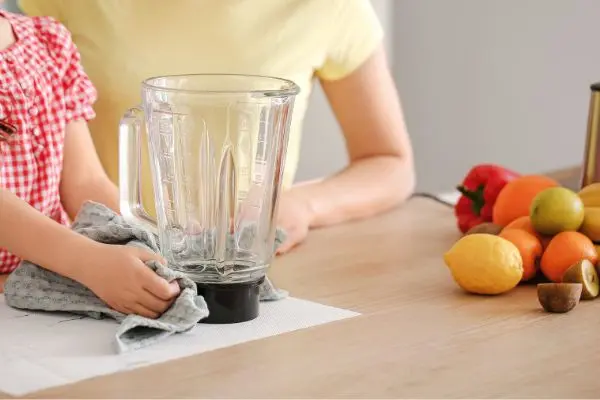
It is important to clean blenders after each use. Unless the motor and blades are properly cleaned, food particles may get stuck in the motor or around them.
If not rinsed and appropriately removed, liquids can become sticky and leak or cause moving parts to stop working. If anything gets in the way, there can be problems or makes it difficult for the blades to move.
In this case, the motor will be more likely to be strained, or the blades will rub against other parts of the blender.
If you use a dirty blender or if it is not cleaned properly, it will run loudly and eventually stop.
7. Something Is Loose
When blenders run, there are a lot of things that move inside and outside.
It is common for blenders to have a lot of parts, and while the motor is contained, other items can come loose and become stuck in the blades or even fall into the motor.
When the blender runs and vibrates, these loose parts move around. When more parts are loose, the sound will be louder.
If loose parts vibrate or shake too much, they may eventually fall off and no longer operate.
If something is loose, the sound may sound more like a rattle than a mechanical sound.
When the blender is run or operated, the parts that become loose and rattle the most are the lids, handles, buttons, and the base.
8. Broken Parts
There’s a possibility that things might break off in a blender. It is possible for the lids, screws, blades, and even small pieces of plastic around the base of the blender to come loose and break off.
It can cause problems with the entire appliance if these pieces are not in the correct positions.
As a result, you may be able to move more, move improperly, and put more strain on the motor, which will make the blender noisier.
Having a misplaced or broken part in a blender may also pose a risk to the user. There is a risk of overheating, catching on fire, or even electrocuting yourself.
In most cases, when someone assumes something is broken, they do not take the time to inspect their blender and do not attempt to repair the problem.
9. Put Together Wrong
Most blenders are easy to assemble and ready for use right out of the box.
A few may require some assembly.
Generally speaking, the blender will consist of a motor and a base that are one piece, and the pitcher and lid will be separated.
There are also blenders with double lids that allow you to add food or liquids, as the blender works without having to remove the entire lid.
During the blending process, if any of these parts are not properly installed or attached, they will vibrate, rattle, and make quite a bit of noise.
10. Couplers Fail To Function Properly
Grinding noises are sometimes caused when couplings or couplers are not performing properly. There are a variety of materials and shapes available in couplers.
However, they tend to fail whenever a pressure overload is applied to the blades.
11. Damaged Base
If your blender’s base is damaged, you will hear continuous grinding noise when you use it. There is a possibility that the base of the blender is making the noise if none of those mentioned above reasons apply.
It is possible that the base of the blender may break or crack. As a result, the pitcher does not sit properly on the countertop.
If the container base is continually overtightened, it can become damaged.
12. Location
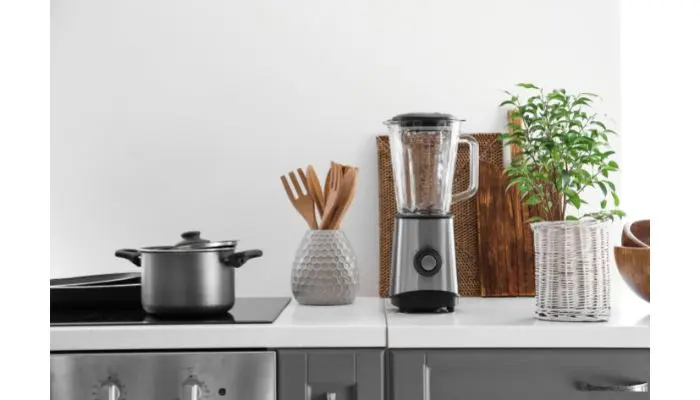
The blender may be noisy depending on where it is kept in your house or kitchen. Depending on the design or layout of the kitchen, blenders can make noise, which can carry through your house.
Blenders that are kept under cabinets may produce a loud echo in the home.
The blender may vibrate and make noise while running if placed on a metal or wooden shelf.
When the blender runs, it may vibrate or shake against other appliances nearby.
Even when a blender is moving on or against a hard surface, vibration sounds can sound as if they are coming from within the blender.
Finally, you know why are blenders so loud. Hopefully, you are thinking about how to reduce blender noise. Don’t worry once you have realized all the reasons for blender sound; it will be easy to fix the issues.
Therefore, now we are going to share how can you make the blender quieter.
How To Make Blender Quieter? Find Out 10 Ways.
In the 21st century, we drive fast cars and use electric appliances and vehicles that are almost noiseless. If this is true, why do blenders and food processors still make so much noise?
Therefore, let’s fix the problems. Here are a few methods you can try to make your blender run more quietly.
1. Move Away From The Wall

The blender may be making noise because it’s too close to other appliances or rattling against a counter or another object, so try moving it to a different location.
You should find a place that has a soft surface and is free from other appliances so that the blender does not get bumped into. Also, ensure the blender is sitting on a level surface.
Thus, it will run more quietly and not move around as much while it is running.
2. Put It On A Rubber Mat
A majority of counters, tables, and cabinets have hard surfaces.
When moving, the blender’s base can hit against it, and the sound of two solid objects can be very loud.
The sound of the blender will be reduced when a rubber mat is placed under it.
3. Keep It In A Towel
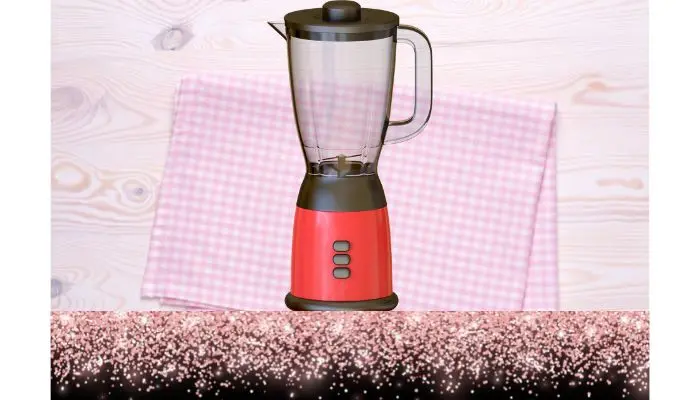
To muffle the sound of the blender, you may want to put a towel over it. Use a towel to silence the blender while operating it.
Using a towel will allow you to silence noise from vibrating objects.
Using the towels will also be helpful if anything spills or the blender moves so much that it causes a mess.
4. Clean It Thoroughly
It’s crucial to properly clean your blender so no food debris or liquid is left behind that could cause the motor to lock up.
Wash the blender thoroughly with dish detergent to remove food particles and gunk from the blades and other moving components.
Before storing it or using it, rinsing it thoroughly and letting it dry completely is a good idea.
5. Decrease Speed
People tend to operate their blenders at high speeds whenever something needs to be pureed or blended smoothly.
Reduce the blender speed to make the blender quiet. But you may have to run it longer, but your food will still be processed to the desired texture at a lower speed.
Furthermore, this will increase the lifespan of your blender by reducing wear and tear.
6. Check The Parts
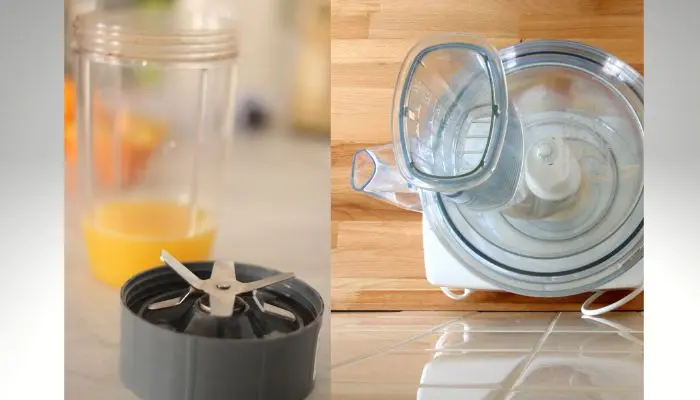
Misconnecting the pieces of blender is possible even though most blenders don’t need many parts.
While lining up and allowing the blender to run, some pieces may not be properly installed or assembled.
If this occurs, the blender may rattle and make a lot of noise.
As a result of fixing the assembly problems, the blender will be stronger and quieter once it has been fixed.
7. Check For Broken Parts
It’s a bad idea to use a blender if one or more parts seem to be damaged. The smallest parts, even those that do not affect the blender’s performance, should be checked and replaced if necessary.
Your blender might be repairable if it was new or expensive. However, if it is old, parts may not be available.
8. Ensure Your Blender Is Level
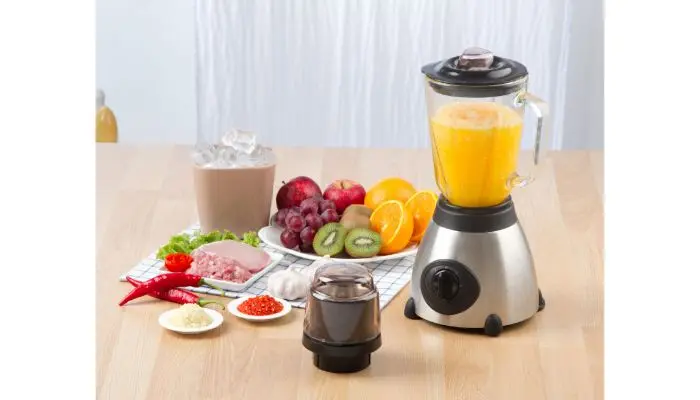
Additional noise will be generated if your blender is rocking back and forth or sliding across a surface. Basically, anything that moves produces noise.
However, you can significantly reduce the amount of noise your blender generates if you ensure that it is firmly placed and level.
9. Use A Blending Box
If you wish, you can make your own noise-reducer blending box out of an old cardboard container. You can use a blending box for sitting your blender inside or using it as an enclosure over the top of your blender.
The inside is covered with sound-dampening material. You don’t need to enclose your blender completely, but it should have at least three sides. They’re commonly found in smoothie shops. They sometimes worked as blender noise reduction.
10. Use Your Manufacturer’s Warranty
Assume your blender is still under warranty, and none of our previous suggestions have helped reduce blender noise. In this case, you should contact the manufacturer of the appliance.
They can assist in determining whether the issue is a product defect. For a warranty claim, you will need the original receipt from the blender manufacturer.
Hopefully, you have a clear concept of how to reduce blender noise. But have you ever thought of replacing your blender with a food processor? Don’t make a decision without deep learning. So, let’s see which one makes a quieter noise: the blender or the food processor.
Is Food Processor Quieter Than A Blender?
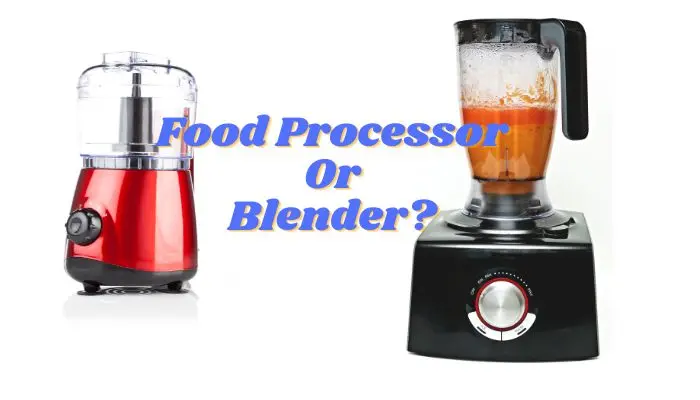
Most food processors operate at much lower speeds than blenders, so they should be slightly quieter than blenders. But, ultimately, the answer depends on many factors.
It all depends on the quality and construction of an appliance, what you are processing, the type of blades you are using, and how fast it runs.
Generally, blenders produce about 88 dB (decibels), but some models run at 68 dB, the same level as everyday conversation. In contrast, food processors average around 80 dB for mid-level models.
Is It Possible To Replace A Loud Blender?
If the sound of blending is upsetting, you might wonder if there are quieter alternatives. Immediately, a food processor springs to mind, and in theory, because they run at a slower speed, they may be quieter, but again, it depends on the conditions in which they would be used.
It is also important to consider that food processors don’t have the same functionality as blenders. The blender can be used to make smoothies and protein shakes, among other things. In addition, it is more durable than the average blender and can process liquids better.
When making dough or chopping vegetables, a food processor is typically used for more labor-intensive tasks. In addition, most food processors cannot handle liquids. Accordingly, this replacement might not be the best choice for you, depending on how you use your blender.
In this case, what should you do? Would you consider purchasing a quiet blender? Then let’s find out what is the quietest blender on the market.
What Is The Quietest Blender In The Market?
With the advancement of technology, blenders have become more sophisticated. Several manufacturers have developed models that are quieter.
Depending on many factors, including the location, type of recipe, and speed of the blender, the two most popular models are Hamilton Beach Professional Blender and Vitamix Quiet One.
They are both powerful machines that should handle any blending needs you might have..
Final Verdict
Hopefully, you have been able to discover all the reasons why are blenders so loud and how to reduce blender noise.
Especially if you live in an apartment with shared walls, blenders can be quite loud, limiting their use. This leads us to ask, how can you avoid the noise?
Several methods exist to reduce noise from blenders, as we explored above. Also, many low-decibel blenders are available that are quieter than normal blenders.

